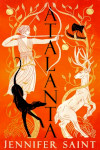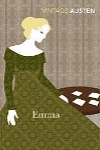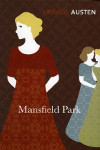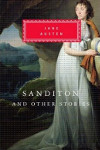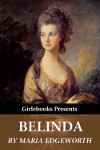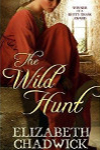Jane Austen – Northanger Abbey
Posted 20th April 2011
Category: Reviews Genres: 1810s, Books About Books, Domestic, Social
1 Comment

In which Austen plays narrator to devastatingly good effect.
Publisher: (Numerous, but I’d wager Vintage would be a good one)
Pages: N/A
Type: Fiction
Age: Adult
ISBN: N/A
First Published: 1818
Date Reviewed: 27th March 2011
Rating: 5/5
Catherine Morland loves Gothic books, in fact she loves them so much that they can overtake reality. That she’s not well-versed in anything else is of no importance to her. As luck would have it, it may not be important to the hero either, at least in his choice of partner. But before she can meet this handsome fellow she must first travel to Bath, because that’s where he is, and must, before they can become well-known to each other, embark on a few irritating friendships.
If my summary sounds strange, it is because I have endeavoured to provide a hint of the style of the book. Austen has no qualms about letting the reader know that this is just a story, and in fact she makes it so that the story is one of the easiest narratives written. She purposefully creates a heroine who is to have little trouble in meeting the hero (she reminds you often that they are the heroine and hero) and points out where she could have made the book stereotypical and chose not to. In essence, the book is far less eventful than many but still very good – but you have to know the style of writing to understand why the contents stop it from being boring.
The book centres on the relationships between three major factions, Catherine and her brother James, John and Isabella Thorpe, and Henry and Eleanor Tilney. All three factions impact each other in various ways, both directly and through the “use” of one another. As you might expect with an Austen novel, love plays its part, as does money, and overall personal situations.
On the whole, Catherine isn’t a particularly interesting character, but Austen focuses on her quirks in order to make the story the success it is. Catherine is a sensationalist and some of the humour in the book inevitably arises from her love of Gothic novels and the value she places on the information in the real world. It’s like the thought that often crosses the mind of an admirer of The Lion, The Witch And The Wardrobe to investigate any old-fashioned wardrobes they come across; but unlike these more modern thoughts that are meant only in jest by all but children, Catherine’s thoughts that stem from her novels become a reality to her, and the chastising she gives herself for it being a fantasy is only half-hearted. That her imagination is taken advantage of several times by Tilney is to create not only humour but also a situation in which Catherine can develop as a character, as well as to make Tilney himself not only a brilliant hero but to demonstrate Austen’s own superb mind.
If Henry had been with them indeed! – but now she should not know what was picturesque when she saw it.
Catherine’s development in regards to general knowledge, which includes general social knowledge, may not be particularly detailed, but it is fun to read about and good to be able to imagine where she might be in a few years time.
The other characters are almost equally compelling. Although not as passionate and impulsive as Catherine (in Northanger Abbey I found the spin-off, of sorts, that I would have loved to see of Charlotte Brontë’s Villette, focusing on Ginerva Fanshawe) they each possess distinctly interesting qualities. Henry Tilney is sarcastic, intelligent, and, I would say, the way in which Austen divulges her thoughts to the characters; his sister is an obedient woman but unconvinced by general society. Their father is a matriarch and the Thorpe siblings hard to bear, an assuming, self-righteous, deceiving duo.
“Would he thank you, either on his own account or Miss. Thorpe’s, for supposing that her affection, or at least her good-behaviour, is only to be secured by her seeing nothing of Captain Tilney? …Is her heart constant to him [Morland] only when unsolicited by anyone else?”
Something that marvels me about this book is Austen’s detailed knowledge about relationships. I know that so many things about love and relationships only occurred to me after I had experienced them, together with the information from music, books, and movies, and here we have Austen, a woman in the Victorian era, when woman were suppressed, a woman who experienced love but not for a great length of time, discuss subjects so much better than many writers even today.
As to the theme of parental interference, Austen ends the novel leaving the reader to decide whether her work is in support of “parental tyranny” or “filial disobedience”. It’s a fitting way to end the book. That she had pointed out to the reader, several paragraphs before, that she knew that they knew how it would finish, just adds to the superior quality.
The best aspect of this book is the writing. The story is enjoyable but if it had been told in a more regular manner it would be nothing special, and that is it’s selling point.
Northanger Abbey is one of a kind, especially where Austen’s own work is concerned. If you are an admirer of her books but have not yet read it, I urge you to do so in haste.
Related Books
Elizabeth Chadwick – Lords Of The White Castle
Posted 14th April 2011
Category: Reviews Genres: 2000s, Historical, Political, Romance, Social
1 Comment

The lovers are married in a ceremony lasting minutes and then flee from the king. It’s the stuff fairytales are made of.
Publisher: Sphere (Little Brown)
Pages: 673
Type: Fiction
Age: Adult
ISBN: 978-0-7515-3939-4
First Published: 2000
Date Reviewed: 21st March 2011
Rating: 4.5/5
The Fitzwarin family seat was at Whittington until it was taken from them. For years Fulke’s father strove to regain it but when he died it was still in the hands of another and thus Fulke and his brothers took over the fight. Yet Whittington doesn’t remain the only thing in the young man’s mind and once he meets Maude, who he’d first come across when she was a headstrong girl of twelve, his loyalty will be split.
Something that may interest you to know, and to give you a general sense of the book, is that the man this book is based on, Fulke Fitzwarin III, is one of the possibilities for the inspiration of the legend of Robin Hood.
For the longest time I lingered on the fence between wanting to review this novel to let you know how good it is, and not wanting to review it because the idea of reviewing Chadwick’s work seems to me blasphemous. It is just so difficult to explain how amazing her creations are, and indeed the first book I read of hers, Shadows And Strongholds, has still not seen a review from me since two autumns ago when I read it.
The success of the book, above anything else, above the themes, even above the story, is the way that Chadwick makes the history accessible. The style of writing doesn’t so much invite you as envelope you without warning into the world in the book, Chadwick’s style is very much show rather than tell and the details she goes into about the domestic life mean that imaging everything is delightfully simple. Unlike many books where you can be hard pressed to create a whole picture of the scene in your mind, Chadwick’s work fills you in on everything; you hear about the different weapons, the way clothes were made, the cultural traditions such as the bedding ceremony. And as you can no doubt tell from the way I have written it, this paragraph applies just as much to her other books as it does to Lords Of The White Castle.
Because there is not much factual information to go on, and what information there is about the Fitzwarin’s cannot always be trusted, it was inevitable that Chadwick would adopt a more fictional outlook than authors who write of later periods. As someone who thrives on historical fiction that is more or less factual I have to say that it really doesn’t matter here, and dates are included which makes it easier if you later wish to research the factual elements.
The book takes a while to come into it’s own but the lead up to the romance is far from boring, the reader is provided with all the necessary background details and then some, and the characters are strong and well developed. When the romance does enter fully the narrative speeds along because of everything else that is going on. It’s thrilling. Perhaps the best aspects are the times the characters know they are assuming a stereotype and exploit it magnificently.
Fulke smiled at the apprehension in Ivo’s voice. Put his brother in the midst of a melee or ask him to charge across open ground at opposing cavalry and he would not balk. But give him the massive greenery of the Welsh mountain forests and the possibility of wild Welshmen lurking in ambush and he became as anxious as a nun in a brothel.
Humour places a substantial role, although you wouldn’t call the book a comedy. There are some great lines in the story and the metaphors tend to enlist the time period.
“You may seduce me as much as I like,” she declared with a wrinkle of her nose, “but not until we are wed.”
The sex scenes in the book often take place “behind the curtain” so to speak, but when they don’t they are hot and sensual. This doesn’t mean it is erotic fiction, and the words used are not crass, but Chadwick goes further than many romances.
The characters are strong, and Maude, the leading lady, strives to be on a par with her husband – apart from societal constraints, they are equals. There is a brilliant scene where Maude pulls out her crossbow and, after seeing her husband’s hesitation, reminds him that she is better than most men. If you’re looking for a kick-arse chick, you’ll find one here. Fulke is just as good, his dialogue is often priceless and his manner admirable, at least usually. And to bring in the Robin Hood reference I spoke of at the start, Chadwick’s story does include things that relate well to the legend. The rest of the characters are no less developed and the Fitzwarin household and their allies are a joy to read about.
Unsurprisingly Lords Of The White Castle deals with social issues, including the differences in gender. Chadwick generally lets the laws of the period hold sway but often points to times when men were happy to have their women be knowledgeable in politics. The two elements balance well and from her 20th century position she illustrates how some people were ahead of their time. Poignant is the retort made by a man to his father-in-law that if a woman can marry and run her household then she should be able to own land. It strikes as similar to many of the debates we have today regarding the placement of age restrictions, such being able to drive and be married before having the right to vote.
The only problem I had with the book was its length. It carries on for a long while after the threads are tied and although you can understand why it does, because Chadwick is wanting to present you with her version of the relationships, after the afore mentioned threads are tied there is nothing particularly interesting to keep reading for.
Lords Of The White Castle brings a piece of history that is often forgotten to life and fills in the gaps with fiction that is interesting, fun, and believable. If you are at all interested in swords and shields or if you have ever wanted to travel back in time and live in the medieval period then this book for you. And if you’re anything like me then the idea of bread and cheese becomes an incredibly viable option for dinner when hunger strikes and you have to put the book down.
Marketplaces, kings, tournaments, traditional cooking methods, and knights in shining armour coming to rescue their lovers. It’s all here.
Related Books
Elle Newmark – The Sandalwood Tree
Posted 8th April 2011
Category: Reviews Genres: 2010s, Domestic, Historical, LGBT, Political, Romance, Social
1 Comment
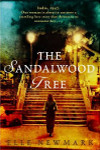
History is always changing because we are always finding out about new aspects of it.
Publisher: Atria Books (Simon & Schuster)
Pages: 357
Type: Fiction
Age: Adult
ISBN: 978-1-4165-9059-0
First Published: 17th February 2011
Date Reviewed: 31st March 2011
Rating: 5/5
It’s 1947 and American Evie has come to India with her husband and son while her husband documents the fall of British rule. Martin has changed since the Second World War and though Evie hoped the move to India would re-ignite their marriage it seems unlikely to happen. In heartache she turns to cleaning in order to gain control where it was lost and it’s here that she discovers a loose brick in their hundred-year-old house. Hidden inside the gap is a bunch of letters dated 1850’s – suddenly Evie has a purpose of her own.
Although I’ve read a lot of books recently that I enjoyed perhaps even more than The Sandalwood Tree, on no occasion have I been able to read without checking every now and then on my progress – until this book. I finished it without really noticing. The book is full to bursting with delightful contents.
Admittedly it probably helps that I’m interested in India and its many cultures and can speak a bit of Hindi (the book contains a smattering of the language) but I’d hope that the immense richness of detail is undeniable to anyone. Newmark may to a certain point exoticise the country, this makes sense considering the time periods she writes of, but it’s the overall research and the way she describes the places that make the book what it is. The colours of the cover match the story perfectly.
The Sandalwood Tree flips back and forth between 1947 – the time of Partition – and the 1850s, when relations between the British and Indians were understandably bad. It details the events that happened during those times (although the book ends before Partition happens so it’s the lead-up that is examined) but the emphasis is on the lives of the characters and the particular social issues relevant to them. Evie, as an American, finds herself more open-minded than the Brits in her circle and so you get to see a few different points of view. Her own story becomes very much effected by the letters she reads, leading her to find India more homely and enabling her to really consider the impact her husband’s years in service have had on their marriage. Her son, Billy, is a joy in himself, being rather bold and knowledgeable and, being five years old in 1940s India, his own development as a character is particularly interesting.
The letters Evie finds become a second plot in their own right. Even though it is Evie who reads the letters and finds out about the women in them, so much time is given to the letters themselves that it’s easy to forget that. This sort of story has been done before, but because of Newmark’s writing style and the connection she makes between the women and Evie, it is fascinating. I should probably say that Evie’s story is told in the first-person, the 1850’s via the letters and a diary. The various social issues covered due to the two characters love interests make the book very compelling.
I would observe and understand India without India actually touching me.
One of the most interesting elements of the book is the way the domestic squeezes its way into the social, and vice versa.
A second conflict of cultures happens as the back-story to Martin’s plight in the form of the Germans and anyone against them. Consider the following:
He said it bothered him that German sounded so much like the Yiddish of his grandparents; then he shook his head as if he was trying to understand something.
Newmark’s point is poignant, that there was no real difference between Jews and Germans other than religions. Martin’s experiences, when put against the issues surrounding partition add another layer of thought to the book, show in both cases how society can change so quickly when a line is drawn in the middle.
The only thing I took issue with was the phrase “buttoning the curtains down” within the letters written in the 1850’s by British people. I have come to recognise the phrase “button down” through reading American literature, but it’s not something we say in Britain and thus is out of place in an old English letter. But I feel I have demonstrated my feelings overall: this book is pretty near perfect.
The Sandalwood Tree brings many different generations, cultures, religions, nationalities, domestic situations and opinions to its relatively modest 357 pages, and deals with all effectively. Whether the research is spot-on I can only say as much as I know personally, but it definitely comes across as a triumph all round.
The answer to would I recommend this book is a resounding “yes”.
I received this book for review from the author thanks to Pump Up Your Book.
Related Books
None yet
Ella Drake – Jaq’s Harp
Posted 29th March 2011
Category: Reviews Genres: 2010s, Erotic Romance, Fantasy, Science Fiction
1 Comment

Magic beans aren’t just for kids.
Publisher: Carina Press
Pages: 56
Type: Fiction
Age: Adult
ISBN: 978-1-426-89123-6
First Published: 21st February 2011
Date Reviewed: 3rd March 2011
Rating: 3.5/5
Jaq’s sister is dying of a disease that only those who live and work in the sky can cure. Knowing that, as an agent of a covert corporation, she can secret herself up to the floating islands courtesy of her colleague’s beanstalk, Jaq prepares to find the antidote. She may also discover her ex-fiancée in the process.
The set-up for Jaq’s Harp is very good, a blend of science fiction and fairytale, and as before for Silver Bound, Drake successfully creates a world that is fascinating to read about. You are given all the details necessary at any given time to imagine the scene.
The characters are interesting and because of the short page count you get to see how they handle a number of different emotions one after another. Jaq is your kick-ass chick and although you know how Jaq’s mind reels at the sight of her boyfriend, it doesn’t stop her later saving the day. The background story of the characters is given enough time so that you understand their love. I think I would’ve liked to see Jaq take more of a role in the retrieval of the antidote but it didn’t hinder the story.
The inclusion of the fairytale works very well, it’s changed enough to be almost Drake’s own work in its entirety. Having the islanders called Giant Corps is surprisingly original because at times it’s easy to forget the children’s story and so the term nudges your memory.
Once again I find myself saying that I would love to read a story that explores Drake’s world further. The book is apt for the time Jaq’s mission would have taken, it’s only a short mission after all, but it would be great to know that you have more space to really enjoy being in the world created.
The only issue I had was with the romance, not because it’s included, but because its initial placement puts a damper on the pacing. The story begins by throwing you into the situation, racing along as Jaq makes her way towards the enemy and then stops suddenly. It stops so that the heroine can meet her hero, which is fine, but when they start considering whether or not to have sex when they should actually be getting the hell out of there it becomes unrealistic, obvious fantasy genre aside. Romance was to be expected with this book but as Drake shows with a well-timed sex scene at the end, there are better places for it.
To the sex scenes themselves, they are hot. The characters are in love, the details are bold and obvious, the latter more so perhaps than in Silver Bound. The last sex scene ends on a written triumph.
If there’s one single thing I’d like to point out amongst everything else, it’s the inability of the sky-dwellers to look down and the rarity of an earth-dweller looking up. The whole social issue is summed up in that one factor.
If the beanstalk was exciting when conquered once, Jaq’s Harp illustrates that it can be just as exciting when conquered twice.
I received this book for review from Carina Press.
Related Books
Véronique Olmi – Beside The Sea
Posted 23rd March 2011
Category: Reviews Genres: 2000s, Angst, Domestic, Psychological, Translation
3 Comments

When obsession takes over everything else.
Publisher: Peirene Press
Pages: 103
Type: Fiction
Age: Adult
ISBN: 978-0-9562840-2-0
First Published: 2001 in French; 2010 in English
Date Reviewed: 9th March 2011
Rating: 5/5
Original language: French
Original title: Bord de Mer (By The Sea)
Translated by: Adriana Hunter
A mother takes her children out of school to go on a trip to the seaside. She wants to take them and herself away from everything and thinks that they should see the sea. They spend the time in a grotty hotel and have little money to spend. It will be the last journey they take.
All that I’d heard about this book could never have prepared me for what I was going to experience. Beside The Sea deals with depression, obsession, and mental illness, although the only one of these issues actually confronted by the mother in words is depression, and then only swiftly. A big part of the problem is that the mother is having a hard time accepting that she has a problem, rather than everything that affects her being caused by society and the world in general. Practically every sentence uttered is to do with a certain issue.
The way the book is written aptly projects the mother’s mindset. Short sentences, the sudden inclusion of swear words and other harsh statements indicate she’s become extremely irrational, as does the way she recounts the conversations of others. This means that the book is, to use a metaphor, one punch after another, repeatedly, beginning in a way that you feel you can understand her reasoning and ending in a way so incomprehensible to anyone but the mother.
It’s been the same sailor for thirty years, what I mean is the way I see him’s still the same, he’s still got his torn clothes and holes in his boots because it’s the bit about “boots all worn” that really matters, it’s terrible having sore feet, and shoes are the ruination of many a mother.
Olmi also shows us how troubled the woman has become by allowing us to see how others have responded. We are told about visits from the social worker and about things that other people have commented on, all described from the mother’s point of view. This means that the reader can understand what other people have done to try and help, and we see the reasons why the woman is against it. Unfortunately it also means that the reader is the one in the middle, wishing the social workers had made more inquiries in order to know what they, the reader, do.
The sad thing is that although the woman is staunchly against her children mixing in the world and she’s afraid of it for herself, you can tell that a part of her is desperate to be included and that perhaps if she was accepted by people, no matter how many (for it seems she has no friends) she might be alright. But then she is her own worse enemy in that respect, making a point of only leaving her home when others aren’t around outside.
One of the biggest issues is a spin-off of the woman’s personal problems – neglect. Because the woman thinks mostly of herself, even when she believes she is thinking of her children, we see, through what she says, that the children, especially the eldest, are not coping. The youngest is still at an age where he doesn’t understand but Stan is nine and has ultimately become the adult in the family. The mother sees what Stan does as being against her, and at times she’s right, but when he is against her it is because he is becoming both frustrated and depressed himself. Stan’s actions, such as the episode at the seashore where the mother describes how he runs into make-believe walls, show the boy’s torment. Stan clearly understands what has happened to his mother and understands that he has to look after both her and his younger brother, but at the same time he sees that the world isn’t as bad as his mother makes out. The wall incident provides the metaphor for the times when he is trying to get through to his mother and fails, and the later dream his mother has of his walking into the sea but not drowning shows her misunderstanding of the other situation. Stan walks into the sea. The sea represents the world, but unlike what the mother is expecting, the sea doesn’t swallow him up, rather he walks through it boldly. Although we are shown that Stan is bullied we are also shown his strength and when he hits his mother all the hurt and burdens he carries with him are presented.
The above is summed up by the following statement:
…he looked so alone… how could he cope so well without me?
Unfortunately because of the difference in age and understanding of the two boys, Kevin and Stan are not always happy together, but the reader can see where Stan is trying to pull Kevin to “safety” as his mother holds onto the child’s unconditional love.
…it’s like he’s laughing to hear himself laugh, that he’s making the most of that laughter, having fun with it, and I know that a laugh like that runs away the minute you grow up.
To refer back to Stan’s strength I would like to comment that the metaphors and usage of imagery to demonstrate the other character’s emotions is absolutely fantastic. It’s rare to find a book so powerful in so many respects.
Why did the mother tell this tale? We are not given an explanation – was it just because she was thinking of it as one might as they write a diary, are we seeing it as it plays out, or is she giving a statement to the authorities? The last is a possibility purely because of what occurs – the book ends without the reader knowing what happens afterwards. But it gives you a glimpse as to how a mind can be thus affected, even if we do not know how long she has been like this or if there was a specific event or thought that triggered it.
The book has a truly haunting quality in that the issues at hand are never resolved and because they are supplied in such detail they are more difficult to accept than the unresolved issues in many other books.
The writing, and dare I say this English translation, for we must give Adriana Hunter her good due, is exquisite, the structure is superb, and what is at once a simple book and a complex one is just incredible.
Beside The Sea is a difficult read but is of great importance for the frank reality it shows of the workings of a mind in such turmoil.
Beside The Sea was originally written in French, and, as previously said, was translated into English by Adriana Hunter.
Related Books
None yet











